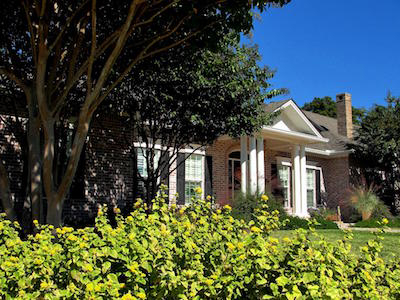
Standard sized crapemyrtles shade the front walls and windows of this East Texas home.
August 22, 2023 - Folks, it has been hot and miserable. Especially in and around my old farmhouse. Energy conservation and environmental quality are among the most critically important issues of our time. Global warming and the greenhouse effect are becoming familiar terms used to describe what is considered by many as a significant climatic change largely brought about by fossil fuel emissions. To reverse these trends, it is important to identify practical solutions to this growing challenge.
The use of basic Earth-Kind landscaping principles and practices can significantly modify the micro-climate surrounding homes and communities, making them more energy efficient, while lower utility costs. Although it is not possible to control temperature, wind, and other weather elements, properly placing trees, shrubs, vines, and structures in the landscape can assist in keeping homes and surrounding areas warm in the winter and cool in the summer. If the landscape is well planned, installed and maintained, the increased aesthetic value and decreased maintenance costs can result in increased real estate values. A well-planned Earth-Kind landscape is one of the best investments a home or business owner can make.
Protection from the sun: Trees can reduce summer temperatures significantly. Shading the roof of a house from the afternoon sun by large trees can reduce temperatures inside the home by as much as 8 to 10 degrees F. Deciduous trees (those that lose their leaves in winter) provide summer shade, then drop their leaves in fall, which allows the warmth of the sun to filter through their bare branches in winter to help warm the home. If a home can be situated to take advantage of shade from existing trees on south and west exposures, energy expended for cooling can be considerably reduced.
To shade the roof or a wall of a one-story home, trees which will reach a medium to large size should be selected and placed 15 to 20 feet from the side or 12 to 15 feet from the corner of the structure. To be most effective, the canopy of the tree should extend over the roof. Smaller trees such as crapemyrtles, redbuds, and vitex can be planted closer to the house and used for shading walls and window areas. Since they are deciduous, these plants will provide shade during the summer and allow light and sun to penetrate during the winter.
Another way to reduce energy consumption with trees and shrubs is to provide shade for the outside portion of a split system air conditioner. A study by the American Refrigeration Institute shows that this practice can reduce the temperature inside a home by as much as 3 degrees F. However, shrubs planted near the compressor should not obstruct air flow or service access. Screening outdoor air conditioning equipment with plantings not only reduces energy consumption but can also enhance the aesthetic appearance of a home or business. Just remember to wait until fall for cooler temperatures and more moisture before planting any trees and shrubs.
To read the “Landscaping for Energy Conservation” publication in its entirety or for more information on Earth-Kind landscaping, visit the Aggie Horticulture website.
Greg Grant is the Smith County horticulturist for the Texas A&M AgriLife Extension Service. He is the author of Texas Fruit and Vegetable Gardening, Texas Home Landscaping, Heirloom Gardening in the South, and The Rose Rustlers. You can read his “Greg’s Ramblings” blog at arborgate.com and read his “In Greg’s Garden” in each issue of Texas Gardener magazine (texasgardener.com). More science-based lawn and gardening information from the Texas A&M AgriLife Extension Service can be found at aggieturf.tamu.edu and aggie-horticulture.tamu.edu.








